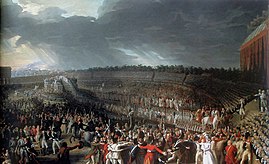Rythenean Revolution
This article is incomplete because it is pending further input from participants, or it is a work-in-progress by one author. Please comment on this article's talk page to share your input, comments and questions. Note: To contribute to this article, you may need to seek help from the author(s) of this page. |
| Rythenean Revolution | |||||||
|---|---|---|---|---|---|---|---|
| |||||||
| |||||||
| Belligerents | |||||||
|
|
| ||||||
| Commanders and leaders | |||||||
|
|
| ||||||
| Strength | |||||||
| 58,000 | 43,000 | ||||||
| Casualties and losses | |||||||
| 19,000 | 17,000 | ||||||
The Rythenean Revolution, also known as the Rythenean Revolutionary Wars, was the republican revolt against the monarchy between 1790 and 1793, and later again in 1824. The revolutionaries defeated the royalists in the war, which caused the overthrow of the seven-hundred year old regime, and the establishment of the First Republic.
Revolutionary tensions first arose after Charles IV revoked the 1622 International Market Act in 1786, which removed the upper classes' rights to trade with parts of Auressia following the nation’s failure during the War of the Tyrnican Succession. As the war was unpopular to begin with, this caused a stir among wealthy traders, who were struggling to find new trading prospects. Many proceeded to smuggle goods, however, Charles began to police the issue by imposing naval patrols throughout the Strait of Casmire. This was seen as an inhibition of the people’s right to free movement as many were left isolated from the mainland, which sparked a wide range of strikes including the famous March on Crown Avenue, where the protesters camped outside the King’s palace for two nights before they were forcefully removed off the premises.
Eventually tensions reached a peak in April 1790, following King Charles’ Proclamation of Dissent which outlawed all political protests and ordered the execution of well known revolutionaries. A week later on the 16th of April, a large mass of citizens in Hyreathe stormed the royal residence and burnt it down in what became popularly known as the ‘spark that ignited the blaze of revolution.’ Following this act of open rebellion, Charles IV declared the need to quash the enemies that opposed the nation’s interests, and war broke out between the royalist and republican forces. The national army dominated the first battles of revolution, however, the establishment of the Delegated Assembly as a war committee and prospective government saw a more unified republican war effort. The conflict ended with the execution of King Charles IV and the founding of the First Republic on 26 November 1793.
Initially headed by President Richard Matthews, the immediate effects of the revolution saw to the acknowledgement of the people’s right to vote, the passing of the first democratic constitution in Rythene, and the enforcement of eighteenth century ideals. As most of the conflict had been fought on the island, the newly founded republic were unable to control the majority of mainland Rythene, and Casmire remained independent from the republic until the second revolution in 1824.
Background
War of the Tyrnican Succession
- Rythene sides with Vervillia in Louis the Vervillian’s claim to the throne.
- With their defeat in the war, Rythene loses Rum Gulf territories to Tyrnica as part of the terms of peace.
1622 International Market Act
- Initially passed as a means to secure trade between prominent Auressian countries.
- In retaliation to the War of the Tyrnican Succession, Charles IV revokes the act which closes the Strait of Casmire to Tyrnican ships.
- Rythenean merchants became disgruntled, and formed the primary revolutionary class during the first uprising.
Proclamation of Dissent
- Prohibited political protests, and ordered the imprisonment and execution of noteworthy revolutionaries.
- The proclamation led to the burning of the royal residence, which is regarded as the start of the revolution.
Revolutionary Wars
- Charles IV flees to Casmire after suffering significant losses in Insular Rythene. This causes republicans to declare independence as the monarchy will not compromise with their demands.
First Republic
Elections
- The First Republic was initially led by Richard Matthews, who was the leader of the interim government until the first elections held in 1795.
- William Tyler was the first elected president of the republic, and only upper class individuals had a right to vote.
Decrees of Idealism
- A list of rights and goals which the First Republic aimed to uphold.
The Great Upheaval
- The revolution triggered the onset of modern republicanism.
- Charles IV died whilst ruling in Casmire, and was succeeded by his son John VII.
- John VII launched an invasion and recaptured Insular Rythene utilising heavy colonial taxes. This inevitably led to Audonia gaining independence.
New Kingdom
Congress of Sabaria
- Establishes a constitutional monarchy in Rythene, and pardons revolutionaries.
Dissolution of parliament
- John VII dissolves parliament under the pretense of incompetence and mismanagement, and states a new government shall be elected.
- The election of parliament is delayed on multiple accounts by the king, and never takes place under his rule.
- The absence of a parliament in Rythene goes against the compromise reached at the Congress of Sabaria.
Anti-revolutionary laws
- Without a parliament present, John VII proceeds to pass a series of laws which orders the imprisonment and execution of known revolutionaries and past presidents, who were pardoned by the Congress of Sabaria.
- John VII was killed by an unorganised mob.
- The previous government’s prime minister excludes their involvement in the event, and the previous parliament forms an interim government.
Second Republic
- Tensions remain between Continental and Insular Rythene.
Vow of Eternal Freedom
- Officially announces the second republic, promises a constitution, and makes it illegal for one person to hold ultimate authority in Rythene.



